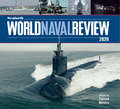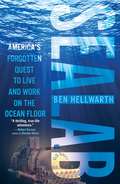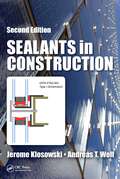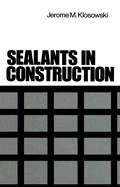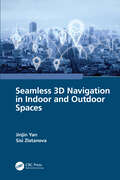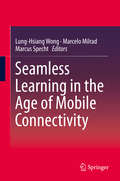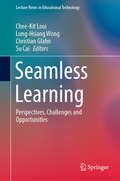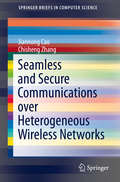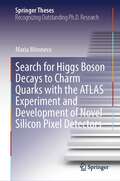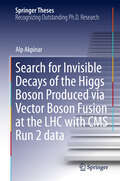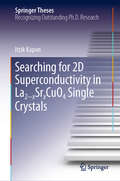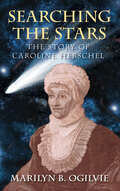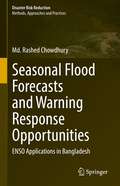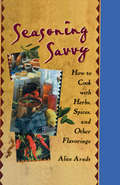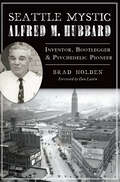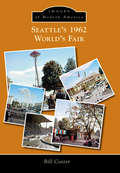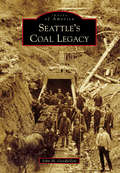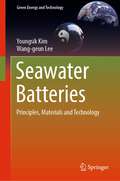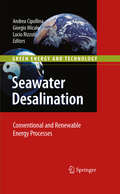- Table View
- List View
Seaforth World Naval Review 2020
by Conrad WatersThis anthology features in-depth assessments of naval innovations and developments around the word by leading experts in the field. The Seaforth World Naval Review 2020 provides an authoritative summary of cutting-edge naval developments across the globe. Regional surveys of fleet evolution and procurement by editor Conrad Waters are supplemented by in-depth articles from a range of experts focusing on significant new warships, technological advances and specific navies. This volume features coverage of the US Navy&’s Virginia class submarines, the Royal Navy&’s Tide class tankers and the Indian P28 Komorto class corvettes. Recent developments in submarine technology are analyzed by Norman Friedman, while David Hobbs&’ usual review of naval aviation focusses on the F35 Lightning II. In-depth fleet reviews look at Finland and Germany and analyze how they are responding to the increased Russian threat. Now firmly established as providing the only annual naval overview of its type, The Seaforth World Naval Review is essential reading for anyone interested in contemporary maritime affairs.
Sealab
by Ben HellwarthSEALAB is the underwater Right Stuff: the story of how a U.S. Navy program sought to develop the marine equivalent of the space station--and forever changed man's relationship to the sea. While NASA was trying to put a man on the moon, the U.S. Navy launched a series of daring experiments to prove that divers could live and work from a sea-floor base. When the first underwater "habitat" called Sealab was tested in the early 1960s, conventional dives had strict depth limits and lasted for only minutes, not the hours and even days that the visionaries behind Sealab wanted to achieve--for purposes of exploration, scientific research, and to recover submarines and aircraft that had sunk along the continental shelf. The unlikely father of Sealab, George Bond, was a colorful former country doctor who joined the Navy later in life and became obsessed with these unanswered questions: How long can a diver stay underwater? How deep can a diver go? Sealab never received the attention it deserved, yet the program inspired explorers like Jacques Cousteau, broke age-old depth barriers, and revolutionized deep-sea diving by demonstrating that living on the seabed was not science fiction. Today divers on commercial oil rigs and Navy divers engaged in classified missions rely on methods pioneered during Sealab. Sealab is a true story of heroism and discovery: men unafraid to test the limits of physical endurance to conquer a hostile undersea frontier. It is also a story of frustration and a government unwilling to take the same risks underwater that it did in space. Ben Hellwarth, a veteran journalist, interviewed many surviving participants from the three Sealab experiments and conducted extensive documentary research to write the first comprehensive account of one of the most important and least known experiments in U.S. history. His compelling narrative covers the story from its scrappy origins in Dr. Bond's Navy laboratory, through harrowing close calls, historic triumphs, and the mysterious tragedy that brought about the end of Sealab.
Sealab: America's Forgotten Quest to Live and Work on the Ocean Floor
by Ben HellwarthSealab is the underwater Right Stuff: the compelling story of how a US Navy program sought to develop the marine equivalent of the space station--and forever changed man's relationship to the sea.While NASA was trying to put a man on the moon, the US Navy launched a series of daring experiments to prove that divers could live and work from a sea-floor base. When the first underwater "habitat" called Sealab was tested in the early 1960s, conventional dives had strict depth limits and lasted for only minutes, not the hours and even days that the visionaries behind Sealab wanted to achieve--for purposes of exploration, scientific research, and to recover submarines and aircraft that had sunk along the continental shelf. The unlikely father of Sealab, George Bond, was a colorful former country doctor who joined the Navy later in life and became obsessed with these unanswered questions: How long can a diver stay underwater? How deep can a diver go? Sealab never received the attention it deserved, yet the program inspired explorers like Jacques Cousteau, broke age-old depth barriers, and revolutionized deep-sea diving by demonstrating that living on the seabed was not science fiction. Today divers on commercial oil rigs and Navy divers engaged in classified missions rely on methods pioneered during Sealab. Sealab is a true story of heroism and discovery: men unafraid to test the limits of physical endurance to conquer a hostile undersea frontier. It is also a story of frustration and a government unwilling to take the same risks underwater that it did in space. Ben Hellwarth, a veteran journalist, interviewed many surviving participants from the three Sealab experiments and conducted extensive documentary research to write the first comprehensive account of one of the most important and least known experiments in US history.
Sealants in Construction
by Jerome Klosowski Andreas T. WolfThe last two decades have seen enormous advances in the technology and application of building sealants. This book provides essential reading for anyone connected with building sealants in the twenty-first century. It covers a wide range of subjects related to building sealants ranging from how to choose sealants and how to determine the key sealant properties and joint design for various applications to specific application tips, along with a forensic section on how to determine the causes of sealant failures.
Sealants in Construction (Civil Engineering Ser. #7)
by Jerome KlosowskiThis comprehensive treatment of the subject assesses the performance characteristics needed for application plus the preformance properties of generic sealants. Illustrated with 100 photos as well as diagrams which explain fundamentals and outline methods to insure the use of appropriate procedures.
Seaman's Guide to Human Factors, Leadership, and Personnel Management
by Jose Rodriguez CordonTraining and certification for Seafarers has been founded on technical aspects, but maybe the most important thing to do aboard a ship is dealing with people. This book, written with seamen in mind, covers areas of expertise that every officer should know to improve motivation, engagement, teamwork, and conflict handling; in short, to be a leader. This book also covers the new requirements for every officer or merchant marine and can be used in courses on this topic. It focuses on seafarers' needs and the language used, avoiding the excessive use of psychological terms, yet keeping the accuracy. Features Covers new requirements for every Merchant Marine Officer Written for and by a seaman, with the accuracy of a psychologist Presents knowledge on how to improve motivation, engagement, teamwork, and conflict handling Includes how to manage people in emergency situations and avoid the loss of lives, like the disaster of Costa Concordia and Estonia
Seamless 3D Navigation in Indoor and Outdoor Spaces
by Sisi Zlatanova Jinjin YanThis book presents the current research on space-based navigation models and the contents of spaces used for seamless indoor and outdoor navigation. It elaborates on 3D spaces reconstructed automatically and how indoor, semi-indoor, semi-outdoor, and outdoor spaces can mimic the indoor environments and originate a network based on the 3D connectivity of spaces. Case studies help readers understand theories, approaches, and models, including data preparation, space classification and reconstruction, space selection, unified space-based navigation model derivation, path planning, and comparison of results. Features: Provides novel models, theories, and approaches for seamless indoor and outdoor navigation path planning Includes real-life case studies demonstrating the most feasible approaches today Presents a generic space definition framework that can be used in research areas for spaces shaped by built structures Develops a unified 3D space-based navigation model that allows the inclusion of all types of spaces as 3D spaces and utilizes them for seamless navigation in a unified way Intended to motivate further research and developments, this book suits students, researchers, and practitioners in the field, and serves as a helpful introductory text for readers wanting to engage in seamless indoor/outdoor navigation research and teaching.
Seamless Learning in the Age of Mobile Connectivity
by Lung-Hsiang Wong Marcelo Milrad Marcus SpechtThe book departs from the approach of related titles by focusing on describing and reflecting upon the notion of seamless learning with regard to salient characteristics of learner mobility and bridging of learning experiences across learning spaces. It is the first such work that is solely dedicated to research on and the practice of seamless learning, uniquely combining interpretations, visions, and past research on and practices in seamless learning from diversified perspectives. The book also strikes a good balance between theoretical and practical perspectivess, going beyond a collection of reports on specific research projects. Instead of thick descriptions of research processes and findings, readers will find significant insights and food for thought intended to inspire further advances in the research on and practice of seamless learning.
Seamless Learning: Perspectives, Challenges and Opportunities (Lecture Notes in Educational Technology)
by Chee-Kit Looi Lung-Hsiang Wong Christian Glahn Su CaiThis book introduces readers to the latest state of research and development in seamless learning. It consolidates various approaches to and practices in seamless learning from a range of techno-pedagogical, socio-situated and socio-cultural perspectives. Further, it details our current understanding of learning in both formal and informal settings, crossover learning, incidental learning, and context-based learning approaches, together with these aspects’ linkages to the notion of seamlessness. The book is divided into sections addressing the theorization of seamless learning, understanding informal learning, research methodological issues, technology-enabled seamless learning and real-world applications of seamless learning. Rounding out the coverage, the final chapter proposes a research agenda for the next 10 years.
Seamless and Secure Communications over Heterogeneous Wireless Networks
by Jiannong Cao Chisheng ZhangThis brief provides an overview of the requirements, challenges, design issues and major techniques for seamless and secure communications over heterogeneous wireless networks. It summarizes and provides detailed insights into the latest research on handoff management, mobility management, fast authentication and security management to support seamless and secure roaming for mobile clients. The reader will also learn about the challenges in developing relevant technologies and providing ubiquitous Internet access over heterogeneous wireless networks. The authors have extensive experience in implementing such technologies over heterogeneous wireless networks, thus enabling them to bridge the gap between the theoretical results of research and the real practice. Combining basic theoretical concepts and practical implementation, this brief is ideal for professionals and researchers in the field. Advanced-level students interested in computer communication networks and wireless technologies will also find the content helpful.
Search and Rescue
by Samantha Glen Mary PesaresiThe crowds got bigger as the team got closer to the Myriad Center. They lined the pavement as if drawn by some invisible force, yet the quiet remained unbroken. Faces along the route were wet with tears that no one tried to hide. Then Beth heard a voice cut the still morning as in prayer. "Yea, though I walk through the valley of the shadow of death, I shall fear no evil." It was a final, wrenching homage to the victims of the bombing. The voice echoed inside Beth's head. "I shall fear no evil," she chanted over and over again, trying desperately to keep her feelings at bay. Beth felt her anger melt away. She and Czar would be all right; she'd make sure of that. The people of Oklahoma had reminded them of what their volunteer of love was all about. The motto of search and rescue-to save lives and reduce human suffering- made it all worthwhile for her and the white shepherd... Beth Barkley was tired of having a life indoors. And so was her white German Shepherd Panda. After reading an article in the newspaoper about search and Rescue dogs, she decided to train with Panda as a canine team. This story is there struggles to become a team, their work, in disasters, from lost children, missing people, an encounter with a bear, to earthquakes in El Salvador, Armenia, and mud slides in Virginia to their hardest challenge helping with the Oklahoma City Bombing. Follow Beth as she trains with first Panda, then Sirius, then Czar, and their adventures, both humorous and sad. Look into the world of search and rescue, the struggles that dog and handle endure every day.
Search for Higgs Boson Decays to Charm Quarks with the ATLAS Experiment and Development of Novel Silicon Pixel Detectors (Springer Theses)
by Maria MironovaThis book explores the Higgs boson and its interactions with fermions, as well as the detector technologies used to measure it. The Standard Model of Particle Physics has been a groundbreaking theory in our understanding of the fundamental properties of the universe, but it is incomplete, and there are significant hints which require new physics. The discovery of the Higgs boson in 2012 was a substantial confirmation of the Standard Model, but many of its decay modes remain elusive. This book presents the latest search for Higgs boson decays into c-quarks using a proton-proton collision dataset collected by the ATLAS experiment at the Large Hadron Collider (LHC). This decay mode has yet to be observed and requires advanced machine learning algorithms to identify c-quarks in the experiment. The results provide an upper limit on the rate of Higgs boson decays to c-quarks and a direct measurement of the Higgs boson coupling strength to c-quarks. The book also discusses the future of particle physics and the need for significant improvements to the detector to cope with increased radiation damage and higher data rates at the High-Luminosity LHC. It presents the characterization of the ATLAS pixel detector readout chip for the inner detector upgrade (ITk). The chip was subjected to irradiations using X-rays and protons to simulate the radiation environment at the HL-LHC. The tests showed that all readout chip components, including the digital logic and analogue front-end, are sufficiently radiation-tolerant to withstand the expected radiation dose. Finally, this book describes monolithic pixel detectors as a possible technology for future pixel detectors. This book is ideal for individuals interested in exploring particle physics, the Higgs boson, and the development of silicon pixel detectors.
Search for Invisible Decays of the Higgs Boson Produced via Vector Boson Fusion at the LHC with CMS Run 2 data (Springer Theses)
by Alp AkpinarThis thesis reports the latest measurements on one of the leading dark matter searches conducted by the Compact Muon Solenoid (CMS) experiment at CERN, leading to some of the most stringent constraints on hypothesized interactions between the Higgs boson and dark matter. The thesis also includes further research about the future outlook of the experiment, including exploratory research on the adaptation of deep learning models in future dark matter analyses to improve analysis sensitivity, and the design of a new type of data processing hardware to be used in the next phase of the CMS experiment.
Searching Speech Databases: Features, Techniques and Evaluation Measures (SpringerBriefs in Speech Technology)
by Leena Mary Deekshitha GThis book presents techniques for audio search, aimed to retrieve information from massive speech databases by using audio query words. The authors examine different features, techniques and evaluation measures attempted by researchers around the world. The topics covered also include available databases, software / tools, patents / copyrights, and different platforms for benchmarking. The content is relevant for developers, academics, and students.
Searching for 2D Superconductivity in La2−xSrxCuO4 Single Crystals (Springer Theses)
by Itzik KaponA new experimental method – the "Stiffnessometer", is developed to measure elementary properties of a superconductor, including the superconducting stiffness and the critical current. This technique has many advantages over existing methods, such as: the ability to measure these properties while minimally disturbing the system; the ability to measure large penetration depths (comparable to sample size), as necessary when approaching the critical temperature; and the ability to measure critical currents without attaching contacts and heating the sample. The power of this method is demonstrated in a study of the penetration depth of LSCO, where striking evidence is found for two separate critical temperatures for the in-plane and out-of-plane directions. The results in the thesis are novel, important and currently have no theoretical explanation. The stiffnessometer in a tool with great potential to explore new grounds in condensed matter physics.
Searching the Stars: The Story of Caroline Herschel
by Marilyn B OgilvieCaroline Herschel is best known as the less significant sister of the astronomer William Herschel. Yet the romantic notion of her tirelessly working for her brother while he made his studies of the heavens, documenting his discoveries so he could achieve greatness in the scientific world, couldn't be further from the truth. When Caroline wasn't working as her brother's assistant, she was sweeping the stars with her own small telescope given to her by William. Not only did she unearth three important nebulae, but she discovered no fewer than eight comets in her own right. When William became Astronomer Royal to King George III in 1782, Caroline too received an annual salary, making her the first ever woman to work as a professional scientist. William was made a fellow of the Royal Society in 1781 after discovering the planet Uranus. It wasn't until 1828, but the Society would eventually reward Caroline too, with its Gold Medal. This award would not be awarded to another woman until 1996. Searching the Stars reveals the hardships experienced by a woman pursuing a male profession. Yet how did this unattractive, diminutive woman gain the respect of her professional colleagues, her country and even her king? As Marilyn B. Ogilive investigates this extraordinary life, the determination, humility and passion of one unremarkable woman come to light.
Seasonal Flood Forecasts and Warning Response Opportunities: ENSO Applications in Bangladesh (Disaster Risk Reduction)
by Md. Rashed ChowdhuryThis book explores the feasibility of using El Niño-Southern Oscillation (ENSO)-based forecasts and early warning systems to prevent losses from floods and droughts in Bangladesh. Despite advances in short-range flood forecasting and information dissemination systems in Bangladesh, the present system is less than satisfactory. This is due to short lead-time products, outdated dissemination networks, and lack of direct feedback from the end-user. One viable solution is to produce long-lead seasonal forecasts—the demand for which is significantly increasing in Bangladesh— and disseminate these products through appropriate channels. As observed in other regions, the success of seasonal forecasts, in contrast to short-term forecasts, depends on consensus among the participating institutions. Therefore, the primary objective of the book is to revisit and modify the framework of an ideal warning response system for issuance of consensus seasonal flood forecasts in Bangladesh. The book discusses issues related to the 5-stage Flood Forecasts, Warning, and Response System (FFWRS) and emphasizes the role of the seasonal ‘Climate Outlook Forum (COF)’ in Bangladesh. The book also identifies ways to improve forecasting and early warning systems by utilizing ENSO-based climate data and models, and discusses a comprehensive and participatory approach to seasonal flood hazard management in Bangladesh.Several successful case examples of ENSO-based seasonal forecasts and early warning systems from other ENSO-sensitive regions have been documented. The primary audience includes academics and students, government policymakers, engineers, and business leaders.
Seasonal Knowledge and the Almanac Tradition in the Arab Gulf (Palgrave Series in Indian Ocean World Studies)
by Daniel Martin VariscoThis book is the first in English to survey indigenous knowledge of seasonal, astronomical, and agricultural information in Arab Gulf almanacs. It provides an extensive analysis of the traditional information available, based on local almanacs, Arabic texts and poetry by Gulf individuals, ethnographic interviews, and online forums. A major feature of the book is tracing the history of terms and concepts in the local seasonal knowledge of the Gulf, including an important genre about weather stars, stemming back to the ninth century CE. Also covered are pearl diving, fishing, seafaring, and pastoral activities. This book will be of interest to scholars who study the entire Arab region, since much of the lore was shared and continues through the present. It will also be of value to scholars who work on the Indian Ocean and Red Sea Trade Network, as well as the history of folk astronomy in the Arab World.
Seasoning Savvy: How to Cook with Herbs, Spices, and Other Flavorings
by Alice ArndtA unique work dealing in-depth with flavor and flavorings!With the increasing popularity of regional and ethnic cuisines, cooks frequently encounter recipes calling for unfamiliar seasonings. Seasoning Savvy: How to Cook with Herbs, Spices, and Other Flavorings serves as a guide to identifying, locating, selecting, storing and using these exotic ingredients. Well-established flavorings are not neglected as Seasoning Savvy also brings new insights into cooking with these old favorites. No other book supplies so much information about so many herbs and spices as Seasoning Savvy. This book discusses over 100 herbs, spices, flavorings, and blends in detail, describing their origins and how to select, store, and use them--and what the reader might substitute if a seasoning is unavailable. You will also discover the flavor role of foods such as almonds, citrus fruits, and coconuts. Not a cookbook, Seasoning Savvy is a powerful compliment for every recipe and will help you get the most out of the seasonings you use to flavor your food. Within Seasoning Savvy you will explore:how to select and use the right seasonings for a recipe and how to tell if a spice is fresh drying, freezing, toasting, chopping, measuring, and storing herbs and spicesculinary practices in the use of flavorings from chocolate and vanilla to amchur and mastic flavor combinations, including both well-known and exotic blends, flavored oils and vinegars, compound butters and seasoned saltshow to reduce the intensity of some seasonings such as garlic and chili peppersan examination of the nature of taste of flavor along with a history of spice usage in the USbrewing teas and tisanes savvy culinary tips, such as polishing a copper a bowl with lemon juice and salt, or storing a lump of asafetida in the spice cupboard to discourage insects Seasoning Savvy's tips and techniques will help you bring out the flavor in your food and teach you how to use seasonings to achieve the tastes you like. With this vital book, you will transform your cooking from satisfactory to sensational!
Seattle Fire Department (Images of America)
by Richard SchneiderOn June 6, 1889, 25 city blocks of the city of Seattle and every mill, wharf, and warehouse from Union to Jackson Streets were consumed in a firestorm that started when a glue pot tipped over. Both of the Seattle firehouses burned in the devastating inferno, and the result was the end of the volunteer fire department and the formation of the Seattle Fire Department. Seattle got its first fireboat in 1891, at a little fire station at the foot of Madison Street and Alaskan Way, and the department depended on horse-drawn equipment until 1924, when the last horse was retired. Boasting the oldest continuously operating medic unit in America, today's Seattle Fire Department is a proud organization with 34 fire stations and more than 1,000 uniformed personnel.
Seattle Mystic Alfred M. Hubbard: Inventor, Bootlegger, & Psychedelic Pioneer
by Brad HoldenThe biography of an intriguing man who came to Seattle as an inventor and went on to become a bootlegger, a spy, and a proponent of LSD.Seattle has a long tradition of being at the forefront of technological innovation. In 1919, a mysterious young inventor named Alfred M. Hubbard made his first newspaper appearance with the announcement of a perpetual motion machine that harnessed energy from Earth&’s atmosphere. From there, Hubbard transformed himself into a charlatan, bootlegger, radio pioneer, top-secret spy, millionaire and uranium entrepreneur. In the early 1950s, after discovering the transformative effects of a little-known hallucinogenic compound, Hubbard would go on to become the &“Johnny Appleseed of LSD,&” paving the way for the very first generation of psychedelic disciples and beyond. Join author and historian Brad Holden as he chronicles the life of one of the most fascinating figures to emerge from Seattle&’s past.&“A captivating history of one of America&’s most colorful characters—Al Hubbard. Holden dives into the larger-than-life history of a man whose past intersects with rum running, spy rings, police informants, and psychedelics. Brilliantly told, Holden brings Hubbard&’s enigmatic character to life.&” —Erika Dyck PhD, Professor at the University of Saskatchewan, and author of Psychedelic Psychiatry: LSD from Clinic to Campus &“An engaging biography about the mysterious Al Hubbard, who helped pioneer psychedelic therapy and is credited by Stan Grof with developing the model of the high dose inner-directed session to catalyze a mystical experience.&” —Rick Doblin, PhD, founder and executive director of the Multidisciplinary Association for Psychedelic Studies (MAPS) &“This is the remarkable story of Captain Al Hubbard—inventor, con man, secret agent, uranium entrepreneur, and indefatigable LSD apostle, who saw the light while high on psychedelics in the early 1950s and never looked back.&” —Martin A. Lee, author of Acid Dreams—The Complete Social History of LSD: The CIA, the Sixties, and Beyond
Seattle's 1962 World's Fair
by Bill CotterWhen the United States entered the 1960s, the nation was swept up in the Space Race as the United States and the Soviet Union competed for supremacy in rocket and satellite technologies. Cities across the country hoped to attract new aerospace companies, but the city leaders of Seattle launched the most ambitious campaign of all. They invited the whole world to visit for the 1962 Seattle World's Fair, and more than nine million people took them up on the offer. A colorful collection of exhibits turned 74 acres of rundown buildings into a futuristic wonderland where dozens of countries and companies predicted life in the future. The entire city was transformed with the addition of the soaring Space Needle and the futuristic monorail. When the fair ended, the site became a complex of parks and museums that remains a vibrant part of Seattle city life today.
Seattle's Coal Legacy (Images of America)
by John M. GoodfellowIn the 1880s, Seattle became a major coal port in the United States. By 1908, Puget Sound was the third-largest coal port, after New York and Baltimore. For Seattle, the major coal mines were in Issaquah, New Castle, Renton, and Black Diamond, with many other smaller mines throughout King County. Until the petroleum revolution, Seattle exported most of its coal to San Francisco. Because of coal, Seattle became a center for skilled engineers, machinists, and miners for the maritime, manufacturing, mining, and railroad industries, differentiating itself from other lumber towns on Puget Sound. Seattle's Coal Legacy is the story of a frontier town going through an industrial revolution in its own time. The skills and knowledge developed during the coal era-engineering, finance, transportation, manufacturing, etc.-made Seattle the major city it is today.
Seawater Batteries: Principles, Materials and Technology (Green Energy and Technology)
by Youngsik Kim Wang-geun LeeThis book introduces the working principle, materials, and design of seawater batteries and reviews the current state-of-the-art technologies in cells and modules.This book looks at the characteristics of seawater, then reviews the basic electrochemical processes involved in the storage of electrical charge in seawater batteries, and then discusses the development of anode, cathode, and membrane materials, and cell engineering progress. In particular, Chapter 3 contains the latest research and development results for rechargeable seawater batteries. The book has been written for a broad readership including graduate students, academic and industrial researchers working on sustainable, low-cost energy.
Seawater Desalination
by Andrea Cipollina Giorgio Micale Lucio RizzutiA growing proportion of the world's population is dependent on Seawater Desalination as a source of fresh water for both potable and civil use. One of the main drawbacks of conventional desalination technologies is the substantial energy requirement, which is facing cost increases in the global energy market. "Seawater Desalination" presents an overview of conventional and non-conventional technologies, with a particular focus on the coupling of renewable energies with desalination processes. The first section of this book presents, in a technical but reader-friendly way, an overview of currently-used desalination processes, from thermal to membrane processes, highlighting the relevant technical features, advantages and disadvantages, and development potential. It also gives a rapid insight into the economic aspects of fresh water production from seawater. The second section of the book presents novel processes which use Renewable Energies for fresh water production. From the first solar still evaporators, which artificially reproduced the natural cycle of water, technology has progressed to develop complex systems to harness energy from the sun, wind, tides, waves, etc. and then to use this energy to power conventional or novel desalination processes. Most of these processes are still at a preliminary stage of development, but some are already being cited as examples in remote areas, where they are proving to be valuable in solving the problems of water scarcity. A rapid growth in these technologies is foreseen in the coming years. This book provides a unique foundation, within the context of present and future sustainability, for professionals, technicians, managers, and private and public institutions operating in the area of fresh water supply.
